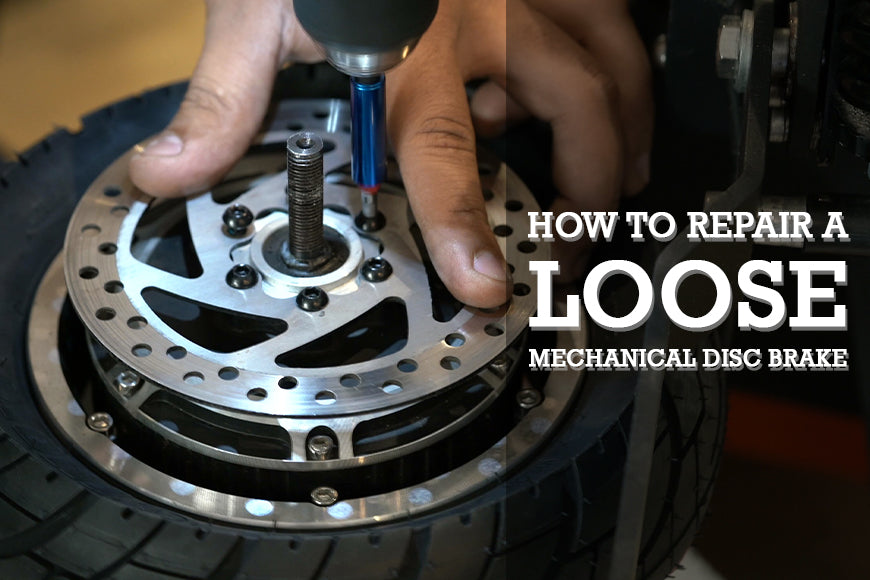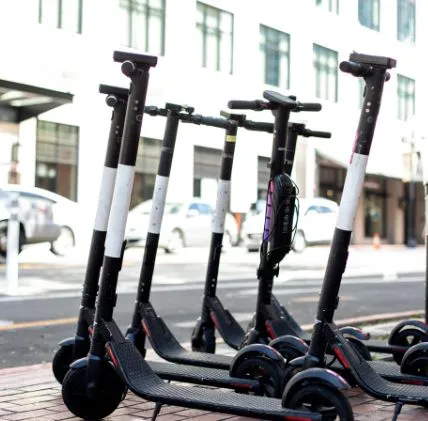To adjust mechanical disc brakes on an electric scooter, follow these steps: loosen the brake caliper, align the brake pads, and tighten the brake caliper. We will discuss the process of adjusting mechanical disc brakes on an electric scooter to ensure optimal performance and safety.
Whether you are a beginner or an experienced rider, understanding how to properly adjust your scooter’s disc brakes is essential. By making these adjustments, you can enhance your scooter’s braking power and responsiveness, ultimately improving your overall riding experience. So, let’s dive in and learn how to adjust the mechanical disc brakes on your electric scooter.

Credit: www.mearth.com.au
Contents
- 1 **Understanding Mechanical Disc Brakes**
- 2 **Signs That Your Mechanical Disc Brakes Need Adjustment**
- 3 **Step-By-Step Guide To Adjusting Mechanical Disc Brakes**
- 4 **Troubleshooting Common Issues With Mechanical Disc Brakes**
- 5 **Maintenance Tips To Keep Your Mechanical Disc Brakes In Top Condition**
- 6 Frequently Asked Questions Of How To Adjust Mechanical Disc Brakes On An Electric Scooter
- 6.1 How Do You Adjust Mechanical Disc Brakes On An Electric Scooter?
- 6.2 Why Are My Electric Scooter’S Disc Brakes Not Working Properly?
- 6.3 What Are The Signs That My Electric Scooter’S Disc Brakes Need Adjustment?
- 6.4 Can I Adjust Mechanical Disc Brakes On My Electric Scooter Without Professional Help?
- 6.5 Are There Any Safety Precautions I Should Take When Adjusting Disc Brakes On My Electric Scooter?
- 7 Conclusion
**Understanding Mechanical Disc Brakes**
Understanding mechanical disc brakes on an electric scooter includes learning how to adjust them properly. This ensures optimal braking performance and enhances safety while riding. Mastering this skill is crucial for scooter owners who want to maintain their brakes and enjoy a smooth and secure riding experience.
Understanding Mechanical Disc Brakes
Mechanical disc brakes are a crucial component of an electric scooter’s braking system. They provide reliable braking power by converting the mechanical force applied to the levers into stopping force. Understanding how these brakes work and their advantages can help you properly adjust and maintain them for optimal performance.
Let’s delve into the various aspects of mechanical disc brakes:
Components Of Mechanical Disc Brakes
- Rotor: The rotor is a metal disc attached to the wheel hub. When the brake is engaged, the brake pads exert pressure on the rotor to slow down or stop the scooter.
- Brake caliper: The brake caliper holds the brake pads and houses the mechanism responsible for squeezing the pads against the rotor.
- Brake pads: These small, replaceable pads are made of friction material and are positioned on each side of the rotor. They create the necessary friction to stop the scooter by firmly gripping the spinning rotor.
How Mechanical Disc Brakes Work
- When the brake lever is squeezed, a cable connected to it pulls the brake caliper arm, causing the brake pads to move towards the rotor.
- As the brake pads make contact with the rotor, the friction created slows down the rotation and ultimately brings the scooter to a stop.
- The pressure applied by the brake pads to the rotor determines the braking force. Adjusting this pressure appropriately ensures smooth and efficient braking.
Advantages Of Mechanical Disc Brakes
- Exceptional stopping power: Mechanical disc brakes offer excellent stopping power, providing reliable and consistent braking even in adverse conditions.
- Self-cleaning: The open design of mechanical disc brakes prevents mud, dirt, and debris from accumulating on the rotor, enhancing their performance and longevity.
- Easy adjustment: Unlike hydraulic disc brakes, mechanical disc brakes can be easily adjusted and maintained without the need for specialized tools or expertise. This makes them more accessible for diy repairs.
- Cost-effective: Mechanical disc brakes are generally more affordable than hydraulic alternatives, making them a popular choice for electric scooter riders who seek reliable braking without breaking the bank.
Understanding the components, functioning, and advantages of mechanical disc brakes is essential for not only adjusting them correctly but also ensuring your electric scooter’s safety and performance.
**Signs That Your Mechanical Disc Brakes Need Adjustment**
If you notice decreased braking power or a squeaking sound, it may be time to adjust your electric scooter’s mechanical disc brakes. Regular inspection and adjustment can ensure optimal performance and safety.
Signs That Your Mechanical Disc Brakes Need Adjustment
If you own an electric scooter equipped with mechanical disc brakes, it is crucial to regularly check and adjust them to ensure optimal performance and safety. Here are some signs that indicate your mechanical disc brakes may need adjustment:
- Squeaking or squealing sounds:
- High-pitched noises coming from your brakes could be a sign of misalignment or wear.
- The brake pads might be rubbing against the disc unevenly, causing friction and noise.
- Adjusting the brake caliper or replacing worn brake pads can help eliminate these sounds and restore smooth operation.
- Reduced braking power:
- If you notice that your scooter takes longer to stop or the brakes feel weaker than usual, it’s time to check the adjustment.
- A common reason for decreased braking power is the brake pads wearing down.
- Adjusting the brake pads closer to the disc or replacing them with new ones can restore the braking performance.
- Uneven brake performance:
- Inconsistent braking on different wheels is a clear sign that your mechanical disc brakes need adjustment.
- Uneven brake performance can result from misalignment of the brake caliper or variations in brake pad thickness.
- Proper adjustment ensures balanced braking force on all wheels and contributes to safe scooter operation.
Regularly inspecting your mechanical disc brakes and addressing any signs of adjustment needs can help maintain optimal braking performance on your electric scooter. Being aware of these indicators and taking proactive measures will ensure safer rides and a longer lifespan for your braking system.
**Step-By-Step Guide To Adjusting Mechanical Disc Brakes**
Learn how to adjust the mechanical disc brakes on your electric scooter with this step-by-step guide. Easy to follow instructions will have your brakes working smoothly in no time.
Step-By-Step Guide To Adjusting Mechanical Disc Brakes
If you own an electric scooter with mechanical disc brakes, knowing how to properly adjust them is essential for maintaining optimal braking performance and your safety on the road. In this step-by-step guide, we will walk you through the process of adjusting your scooter’s mechanical disc brakes.
Make sure to gather the necessary tools and materials before you begin, such as an allen wrench, a cable tension adjuster, and a flat-head screwdriver.
Gathering Necessary Tools And Materials:
To successfully adjust your mechanical disc brakes, you will need the following tools and materials:
- Allen wrench: This will be used to loosen and tighten bolts on the brake caliper and cable tension adjuster.
- Cable tension adjuster: This tool allows you to adjust the tension in the brake cable for proper brake engagement.
- Flat-head screwdriver: You will need this to align the brake rotor, ensuring it is centered within the brake caliper.
Checking Brake Pads For Wear:
Before making any adjustments, it is crucial to inspect your brake pads for wear. Follow these steps to check the condition of your brake pads:
- Remove the wheel from the scooter.
- Locate the brake caliper and visually inspect the brake pads for any signs of excessive wear or damage.
- If the brake pads appear worn down or unevenly worn, it is recommended to replace them.
Adjusting The Brake Caliper Position:
Once you have determined that your brake pads are in satisfactory condition, you can proceed with adjusting the brake caliper position. Here’s how to do it:
- Loosen the bolts that secure the brake caliper to the scooter frame using an allen wrench.
- Position the brake caliper so that it sits evenly on both sides of the brake rotor.
- Tighten the bolts to secure the brake caliper in place.
Aligning The Brake Rotor:
Proper alignment of the brake rotor is crucial for optimal braking performance. Follow these steps to align the brake rotor within the brake caliper:
- Locate the brake rotor between the brake pads in the brake caliper.
- Insert a flat-head screwdriver between the brake pads and gently nudge the rotor to center it within the caliper.
- Spin the wheel to ensure the rotor does not rub against the brake pads.
Adjusting The Cable Tension:
Adjusting the cable tension is necessary to ensure that the brakes engage properly when you squeeze the brake lever. Here’s what you need to do:
- Locate the cable tension adjuster on the brake caliper.
- Loosen the locknut on the adjuster using an allen wrench.
- Turn the adjuster clockwise to increase cable tension or counterclockwise to decrease tension.
- Tighten the locknut to secure the adjuster in place.
Testing The Brakes For Proper Adjustment:
Once you have completed the adjustments, it is crucial to test your brakes to ensure they are properly adjusted. Follow these steps to test your electric scooter’s mechanical disc brakes:
- Put on your safety gear and find a safe area to test the brakes.
- Start riding slowly and gradually increase your speed.
- Squeeze the brake lever gently and ensure that the brakes engage smoothly and bring the scooter to a controlled stop.
- If the brakes feel too loose or too tight, repeat the adjustment process until you achieve optimal brake performance.
By following this step-by-step guide, you can adjust the mechanical disc brakes on your electric scooter, ensuring maximum safety and optimal braking performance. Regularly inspecting and adjusting your brakes is essential to maintain their effectiveness over time. So, take the time to check and adjust your brakes when necessary, and enjoy a safe and smooth ride on your electric scooter.
**Troubleshooting Common Issues With Mechanical Disc Brakes**
Learn how to troubleshoot common issues with mechanical disc brakes on your electric scooter. This article provides step-by-step instructions on adjusting and maintaining your disc brakes for optimal performance.
Troubleshooting Common Issues With Mechanical Disc Brakes
Have you been experiencing issues with the mechanical disc brakes on your electric scooter? Don’t worry, we’ve got you covered! In this section, we will address common problems that you may encounter and provide simple troubleshooting steps to help you get back on the road in no time.
Brake Rub Or Drag:
- Misaligned brake caliper: Make sure the brake caliper is properly aligned with the disc rotor. Loosen the caliper mounting bolts and gently realign it so that there is no contact between the brake pads and the rotor. Tighten the bolts once the alignment is correct.
- Worn brake pads: Check the brake pads for excessive wear. If they are worn down beyond the minimum thickness, replace them with new ones. Worn brake pads can cause rubbing or dragging against the rotor, resulting in poor braking performance.
- Contaminated brake rotor: Inspect the brake rotor for any signs of contamination, such as oil or dirt. Clean the rotor using isopropyl alcohol and a clean cloth to remove any contaminants that may be causing the brake pads to drag.
Brake Pad Contamination:
- Oil or grease on brake pads: If you notice a decrease in braking power or a squealing noise when applying the brakes, it could be due to oil or grease on the brake pads. Remove the brake pads and clean them thoroughly with isopropyl alcohol. Avoid touching the pad surface with bare hands after cleaning.
- Brake cleaner residue: Sometimes, residue from brake cleaner can remain on the brake pads, affecting their performance. Use a clean cloth soaked in isopropyl alcohol to wipe away any leftover residue, ensuring a clean and smooth braking surface.
Brake Cable Issues:
- Loose brake cable: A loose brake cable can result in poor braking performance or uneven braking. Adjust the tension on the brake cable by turning the barrel adjuster. Tighten it for more braking power or loosen it to reduce the tension. Make sure the brake lever engages the brake pads without excessive play.
- Frayed or damaged brake cable: Inspect the brake cable for any signs of fraying or damage. If you notice any, it’s essential to replace the cable promptly. A frayed or damaged brake cable can compromise your ability to stop safely, so it’s crucial to ensure its integrity.
Remember, maintaining your electric scooter’s mechanical disc brakes is essential for your safety on the road. By troubleshooting and addressing these common issues, you can enjoy smooth and reliable braking performance. Don’t hesitate to seek professional assistance if you are unsure or uncomfortable with the troubleshooting process.
Stay safe and happy scooting!
**Maintenance Tips To Keep Your Mechanical Disc Brakes In Top Condition**
Keep your mechanical disc brakes in top condition with these maintenance tips. Learn how to adjust your electric scooter’s mechanical disc brakes for optimal performance and safety.
Maintenance Tips To Keep Your Mechanical Disc Brakes In Top Condition
Regular inspection and cleaning:
- Inspect your mechanical disc brakes regularly to ensure they are in good working condition.
- Look for any signs of wear or damage, such as worn brake pads or loose components.
- Clean your brakes regularly by using a soft cloth or brush to remove any dirt, debris, or rust.
- Check if the brake calipers are aligned properly and adjust them if necessary.
- Make sure the brake cables are properly tightened and free from any kinks or twists.
Lubricating moving parts:
- Apply a lubricant to the moving parts of your mechanical disc brakes to ensure smooth operation.
- Use a high-quality brake grease or oil to lubricate the brake caliper pins, pivots, and springs.
- Avoid applying excessive amounts of lubricant, as it can attract dirt and debris, leading to brake noise and reduced performance.
- Regularly check the lubrication levels and reapply as needed to maintain optimal brake function.
Replacing worn brake pads:
- Inspect your brake pads regularly to determine if they need to be replaced.
- Check the thickness of the brake pads and look for any signs of uneven wear or damage.
- If the brake pads are worn beyond the recommended thickness, replace them with new ones.
- Follow the manufacturer’s guidelines for proper installation and alignment of the new brake pads.
- Bed in the new brake pads by gradually increasing braking force to ensure optimal performance.
Proper storage and handling of the scooter:
- When not in use, store your electric scooter in a cool, dry place to prevent corrosion and damage to the brake components.
- Avoid exposing the scooter to extreme temperatures or moisture, as it can affect the brake performance.
- Securely park the scooter and engage the brake lever to prevent any accidental movement.
- When transporting the scooter, use appropriate measures to protect the brake system from any impact or damage.
Remember, regular maintenance and proper care of your mechanical disc brakes will ensure their longevity and optimal performance. By following these tips, you can enjoy smoother and safer rides on your electric scooter.
Frequently Asked Questions Of How To Adjust Mechanical Disc Brakes On An Electric Scooter
How Do You Adjust Mechanical Disc Brakes On An Electric Scooter?
To adjust mechanical disc brakes on an electric scooter, first locate the adjustment barrel on the brake lever, then rotate it clockwise or counterclockwise to fine-tune the brake’s position.
Why Are My Electric Scooter’S Disc Brakes Not Working Properly?
If the disc brakes on your electric scooter aren’t working properly, it could be due to loose brake cables, improper alignment, worn brake pads, or a damaged rotor. Check and address each of these potential issues.
What Are The Signs That My Electric Scooter’S Disc Brakes Need Adjustment?
Signs that your electric scooter’s disc brakes may need adjustment include a spongy or unresponsive brake lever, excessive travel before the brakes engage, or a rubbing or grinding noise when braking.
Can I Adjust Mechanical Disc Brakes On My Electric Scooter Without Professional Help?
Yes, you can adjust mechanical disc brakes on your electric scooter without professional help by following the manufacturer’s instructions and using basic tools such as an allen wrench and a screwdriver.
Are There Any Safety Precautions I Should Take When Adjusting Disc Brakes On My Electric Scooter?
When adjusting the disc brakes on your electric scooter, make sure the scooter is turned off and the brakes are cool to the touch. Wear protective gloves and eye goggles, and proceed with caution to prevent injury.
Conclusion
Adjusting the mechanical disc brakes on your electric scooter is a crucial skill to ensure a safe and efficient ride. By following the steps outlined in this guide, you can easily make the necessary adjustments and fine-tune the brake system.
Remember to start by inspecting the brake pads and making any necessary replacements. Then, it’s important to check the brake cables, making sure they are properly tensioned and lubricated. Finally, make any necessary adjustments to the brake calipers to ensure a smooth and responsive braking experience.
Regular maintenance and adjustments of your disc brakes will not only enhance your safety on the road but also extend the lifespan of your scooter’s braking system. By taking the time to master this skill, you can confidently enjoy your electric scooter knowing that you have full control over your braking capabilities.
So, go ahead and give it a try!


